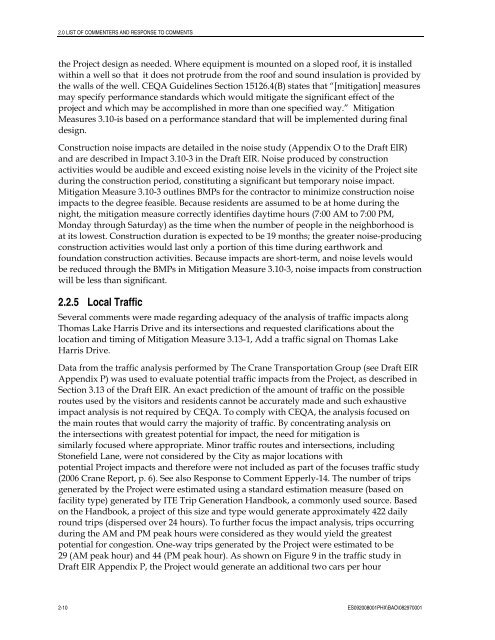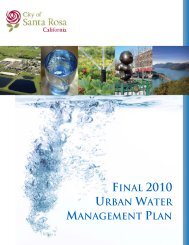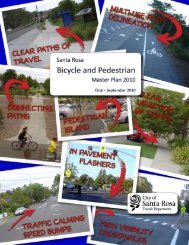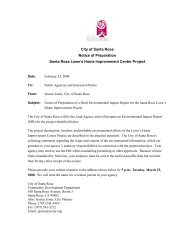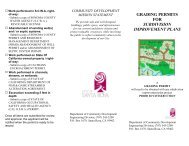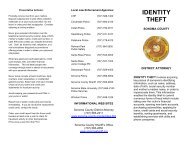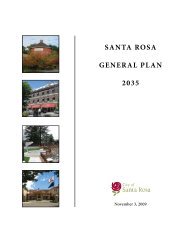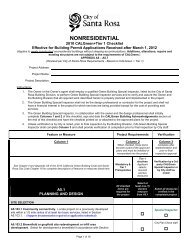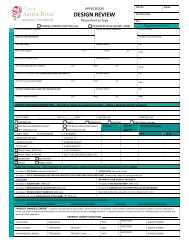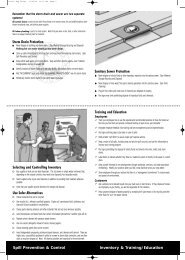Fountaingrove Environmental Impact Report - City of Santa Rosa ...
Fountaingrove Environmental Impact Report - City of Santa Rosa ...
Fountaingrove Environmental Impact Report - City of Santa Rosa ...
Create successful ePaper yourself
Turn your PDF publications into a flip-book with our unique Google optimized e-Paper software.
2.0 LIST OF COMMENTERS AND RESPONSE TO COMMENTS<br />
the Project design as needed. Where equipment is mounted on a sloped ro<strong>of</strong>, it is installed<br />
within a well so that it does not protrude from the ro<strong>of</strong> and sound insulation is provided by<br />
the walls <strong>of</strong> the well. CEQA Guidelines Section 15126.4(B) states that “[mitigation] measures<br />
may specify performance standards which would mitigate the significant effect <strong>of</strong> the<br />
project and which may be accomplished in more than one specified way.” Mitigation<br />
Measures 3.10-is based on a performance standard that will be implemented during final<br />
design.<br />
Construction noise impacts are detailed in the noise study (Appendix O to the Draft EIR)<br />
and are described in <strong>Impact</strong> 3.10-3 in the Draft EIR. Noise produced by construction<br />
activities would be audible and exceed existing noise levels in the vicinity <strong>of</strong> the Project site<br />
during the construction period, constituting a significant but temporary noise impact.<br />
Mitigation Measure 3.10-3 outlines BMPs for the contractor to minimize construction noise<br />
impacts to the degree feasible. Because residents are assumed to be at home during the<br />
night, the mitigation measure correctly identifies daytime hours (7:00 AM to 7:00 PM,<br />
Monday through Saturday) as the time when the number <strong>of</strong> people in the neighborhood is<br />
at its lowest. Construction duration is expected to be 19 months; the greater noise-producing<br />
construction activities would last only a portion <strong>of</strong> this time during earthwork and<br />
foundation construction activities. Because impacts are short-term, and noise levels would<br />
be reduced through the BMPs in Mitigation Measure 3.10-3, noise impacts from construction<br />
will be less than significant.<br />
2.2.5 Local Traffic<br />
Several comments were made regarding adequacy <strong>of</strong> the analysis <strong>of</strong> traffic impacts along<br />
Thomas Lake Harris Drive and its intersections and requested clarifications about the<br />
location and timing <strong>of</strong> Mitigation Measure 3.13-1, Add a traffic signal on Thomas Lake<br />
Harris Drive.<br />
Data from the traffic analysis performed by The Crane Transportation Group (see Draft EIR<br />
Appendix P) was used to evaluate potential traffic impacts from the Project, as described in<br />
Section 3.13 <strong>of</strong> the Draft EIR. An exact prediction <strong>of</strong> the amount <strong>of</strong> traffic on the possible<br />
routes used by the visitors and residents cannot be accurately made and such exhaustive<br />
impact analysis is not required by CEQA. To comply with CEQA, the analysis focused on<br />
the main routes that would carry the majority <strong>of</strong> traffic. By concentrating analysis on<br />
the intersections with greatest potential for impact, the need for mitigation is<br />
similarly focused where appropriate. Minor traffic routes and intersections, including<br />
Stonefield Lane, were not considered by the <strong>City</strong> as major locations with<br />
potential Project impacts and therefore were not included as part <strong>of</strong> the focuses traffic study<br />
(2006 Crane <strong>Report</strong>, p. 6). See also Response to Comment Epperly-14. The number <strong>of</strong> trips<br />
generated by the Project were estimated using a standard estimation measure (based on<br />
facility type) generated by ITE Trip Generation Handbook, a commonly used source. Based<br />
on the Handbook, a project <strong>of</strong> this size and type would generate approximately 422 daily<br />
round trips (dispersed over 24 hours). To further focus the impact analysis, trips occurring<br />
during the AM and PM peak hours were considered as they would yield the greatest<br />
potential for congestion. One-way trips generated by the Project were estimated to be<br />
29 (AM peak hour) and 44 (PM peak hour). As shown on Figure 9 in the traffic study in<br />
Draft EIR Appendix P, the Project would generate an additional two cars per hour<br />
2-10 ES092008001PHX\BAO\082970001


